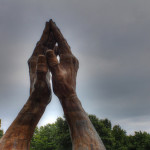We run our website the way we wished the whole internet worked: we provide high quality original content with no ads. We are funded solely by your direct support. Please consider supporting this project.

The Cleansing of the Temple and Non-Violence
Jesus’ cleansing of the Temple is the most commonly cited example of those who allege that he did not absolutize loving enemies or refraining from violence. I submit that this episode implies nothing of the sort. First, it is important that we understand that this episode was not an expression of unpremeditated anger on Jesus’ part, as some allege. Most NT scholars concur that this was a calculated, strategic act on Jesus’ part, and it contained deep symbolic significance. More specifically, this episode appears to be a classic example of a prophetic symbolic action.
There is, however, some disagreement over what exactly Jesus was symbolizing. For example, many argue that Jesus was revealing himself to be the long-awaited messiah who was widely expected to cleanse and/or restore the Temple. Others argue that Jesus was symbolically revealing Yahweh’s displeasure with the corrupt religious establishment and issuing a prophetic warning that the Temple would soon be destroyed, a point that John makes explicit (Jn 2: 19-22). While interpretations differ, however, they all presuppose that the Temple cleansing was anything but a spontaneous tantrum on the part of Jesus.
Second, there is simply no indication in any of the Gospels that Jesus resorted to violence when he cleansed the Temple. Yes, the texts suggest that Jesus was angry, and yes, John tells us that Jesus made a whip (Jn 2:15). But there is no suggestion that he used it to strike any animal or person. To the contrary, throughout history cracking a whip has been a commonly used means of controlling the movement of animals, and John explicitly reports that this is what Jesus used it for. He used the whip to create an animal stampede of “both sheep and cattle” out of the “temple courts” (Jn 2:15). Not only this, but had Jesus actually whipped any of the court officials, it is hard to imagine how he could have avoided being arrested on the spot. It is also hard to imagine how he could have avoided the charge of hypocrisy, for such behavior would have flown in the face of his previously mentioned public teachings about refraining from violence.
There is therefore nothing about Jesus’ cleansing of the temple that runs counter to my claim that the non-violent, enemy-embracing, self-sacrificial love that was supremely revealed on the cross is the thematic center of Jesus’ identity and mission. To the contrary, Jesus engaged in a kind of “street theater” out of love for his “Father’s house” as well as for the poor who were being oppressed by the corrupt leaders who ran the Temple’s “buying and selling” system. And, as the Gospels make clear, he confronted these leaders in this aggressive manner as a way of forcing their hand, and thus as a steppingstone to his crucifixion. Far from illustrating Jesus acting in an unloving, let alone violent way, I submit that this entire episode reflects Jesus’ self-sacrificial love.
Moreover, John explicitly makes the cross the thematic center of this episode, for he records that Jesus brings this episode to a close by drawing a connection between the newly cleansed temple, which Jesus prophesied would soon be permanently destroyed, and his own body, which would rise again three days after being destroyed (Jn 2:19-22). Read in context, NT scholar Richard Hays notes, John is declaring “that Jesus’ body is now the place where God dwells, the place where atonement for sin occurs, the place where the division between God and humanity is overcome.” Hence, far from counting against the thematic centrality of the cross, the Temple cleansing illustrates this centrality.
Photo credit: Lawrence OP via VisualHunt.com / CC BY-NC-ND
Category: General
Tags: Cross, Love, Non-Violence
Topics: Enemy-Loving Non-Violence
Related Reading

Prayer and Co-Reigning with God
God’s primary objective is a world in which free agents love God and one another. For this to be possible, people need a stable environment and freely chosen, irrevocable, morally responsible say-so. Prayer is simply the spiritual side of our morally responsible say-so. We influence things by what we do through our bodies and in…

From Good Friday to Easter
This weekend as you contemplate the suffering, death and resurrection of Jesus, we pray that God will reveal his unfathomable love for you in new ways. Blessings to all of you from all of us at ReKnew. Photo credit: Claudio via Visualhunt / CC BY

Challenging the Habit of Judgment
Jesus said, “Do not judge, or you too will be judged. For in the same way you judge others, you will be judged, and with the measure you use, it will be measured to you” (Matt 7:2). In our world where we encounter a nearly constant stream of judgments on social media or the news,…

Does Romans 13 Condone Government Violence? (podcast)
Greg deconstructs problematic interpretations of Romans 13. Episode 649 http://traffic.libsyn.com/askgregboyd/Episode_0649.mp3

Judgment and Idolatry
Why was the forbidden tree in the center of the garden called The Tree of the Knowledge of Good and Evil? Since the Bible depicts eating from this tree as the reason humans are estranged from God and the cause of all that’s wrong with humanity, eating from this tree is obviously a terrible thing.…

Jesus Came to Bring a Sword?
Jesus said: “Do not suppose that I have come to bring peace to the earth. I did not come to bring peace, but a sword” (Mt 10:34). Some, both modern scholars along with church leaders since the fourth century, have used this passage as evidence to argue that Jesus is not altogether non-violent. When we…
